PGCE Report: A Study on Individual Activities vs. Group Learning
VerifiedAdded on 2022/12/27
|29
|6007
|271
Report
AI Summary
This PGCE report presents a research study comparing individual and group learning activities in a mathematics context. The study involved interviews with students to gather data on their preferred learning methods and perceived effectiveness. The report includes a literature review, methodology, and detailed findings, including a visualization of the research results. Discussions focus on the advantages and disadvantages of each approach, with recommendations for teachers to improve the learning experience. The research highlights the importance of understanding student preferences and adapting teaching strategies to optimize learning outcomes, concluding with reflections on the research process and its implications for future teaching practices.
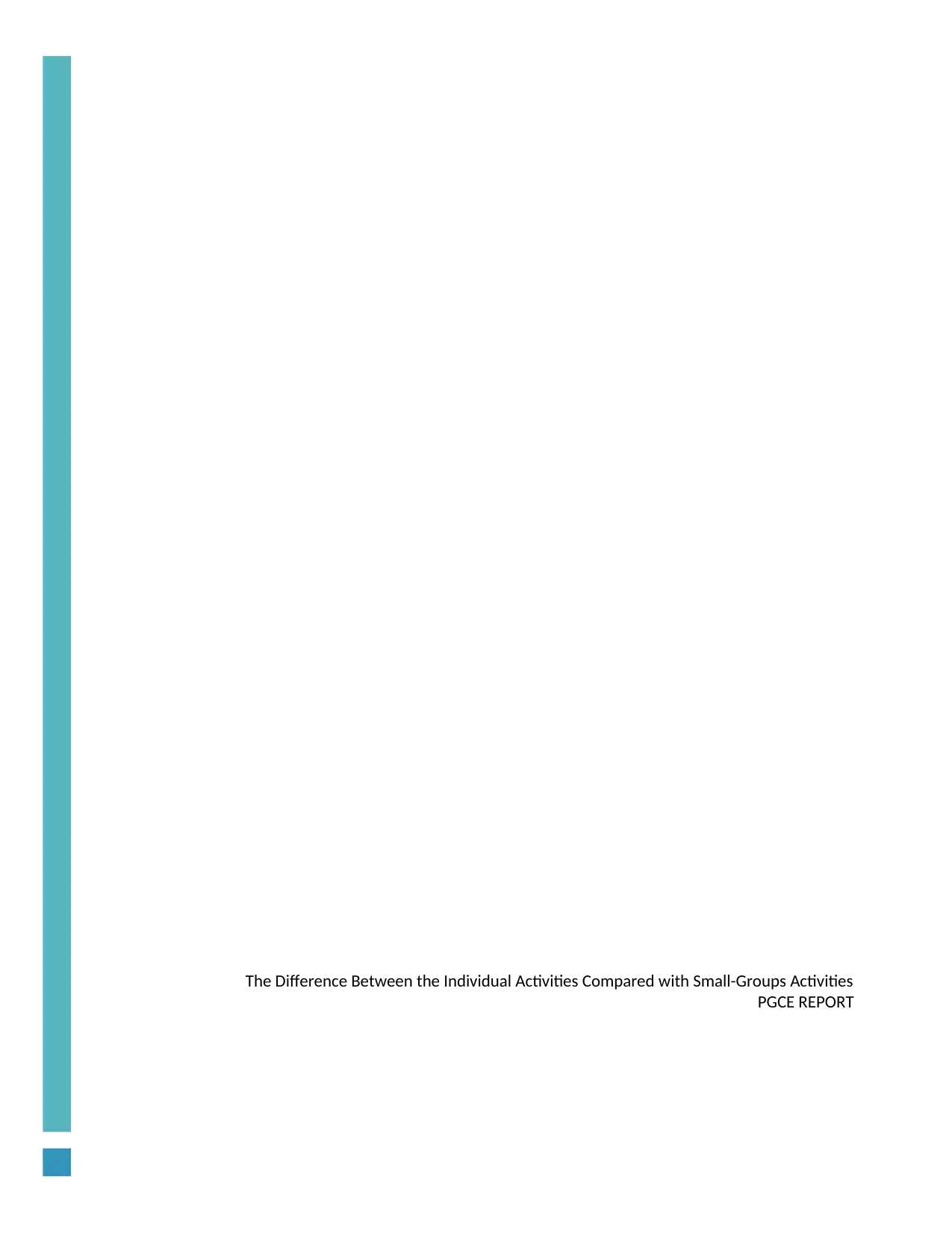
The Difference Between the Individual Activities Compared with Small-Groups Activities
PGCE REPORT
PGCE REPORT
Paraphrase This Document
Need a fresh take? Get an instant paraphrase of this document with our AI Paraphraser
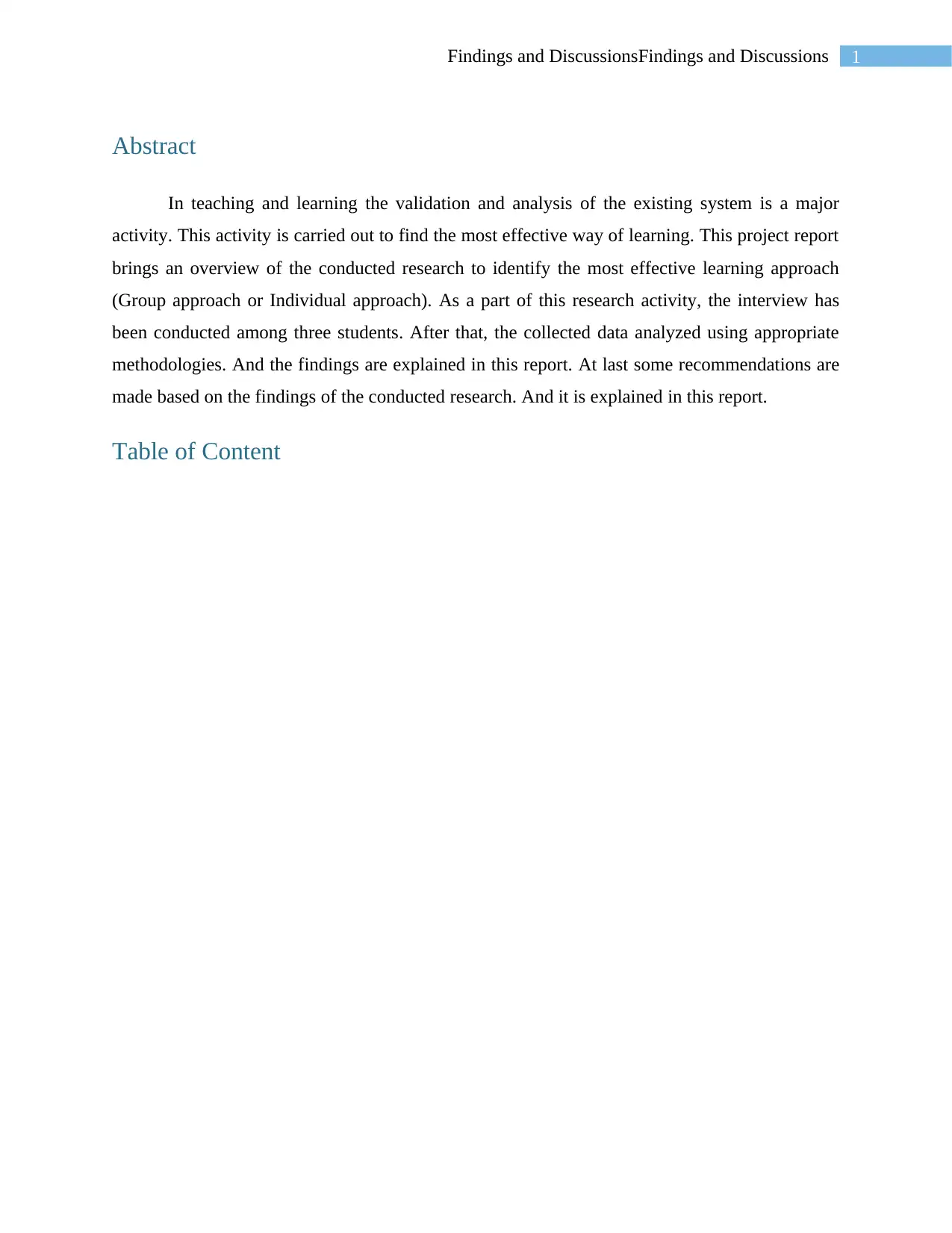
1Findings and DiscussionsFindings and Discussions
Abstract
In teaching and learning the validation and analysis of the existing system is a major
activity. This activity is carried out to find the most effective way of learning. This project report
brings an overview of the conducted research to identify the most effective learning approach
(Group approach or Individual approach). As a part of this research activity, the interview has
been conducted among three students. After that, the collected data analyzed using appropriate
methodologies. And the findings are explained in this report. At last some recommendations are
made based on the findings of the conducted research. And it is explained in this report.
Table of Content
Abstract
In teaching and learning the validation and analysis of the existing system is a major
activity. This activity is carried out to find the most effective way of learning. This project report
brings an overview of the conducted research to identify the most effective learning approach
(Group approach or Individual approach). As a part of this research activity, the interview has
been conducted among three students. After that, the collected data analyzed using appropriate
methodologies. And the findings are explained in this report. At last some recommendations are
made based on the findings of the conducted research. And it is explained in this report.
Table of Content
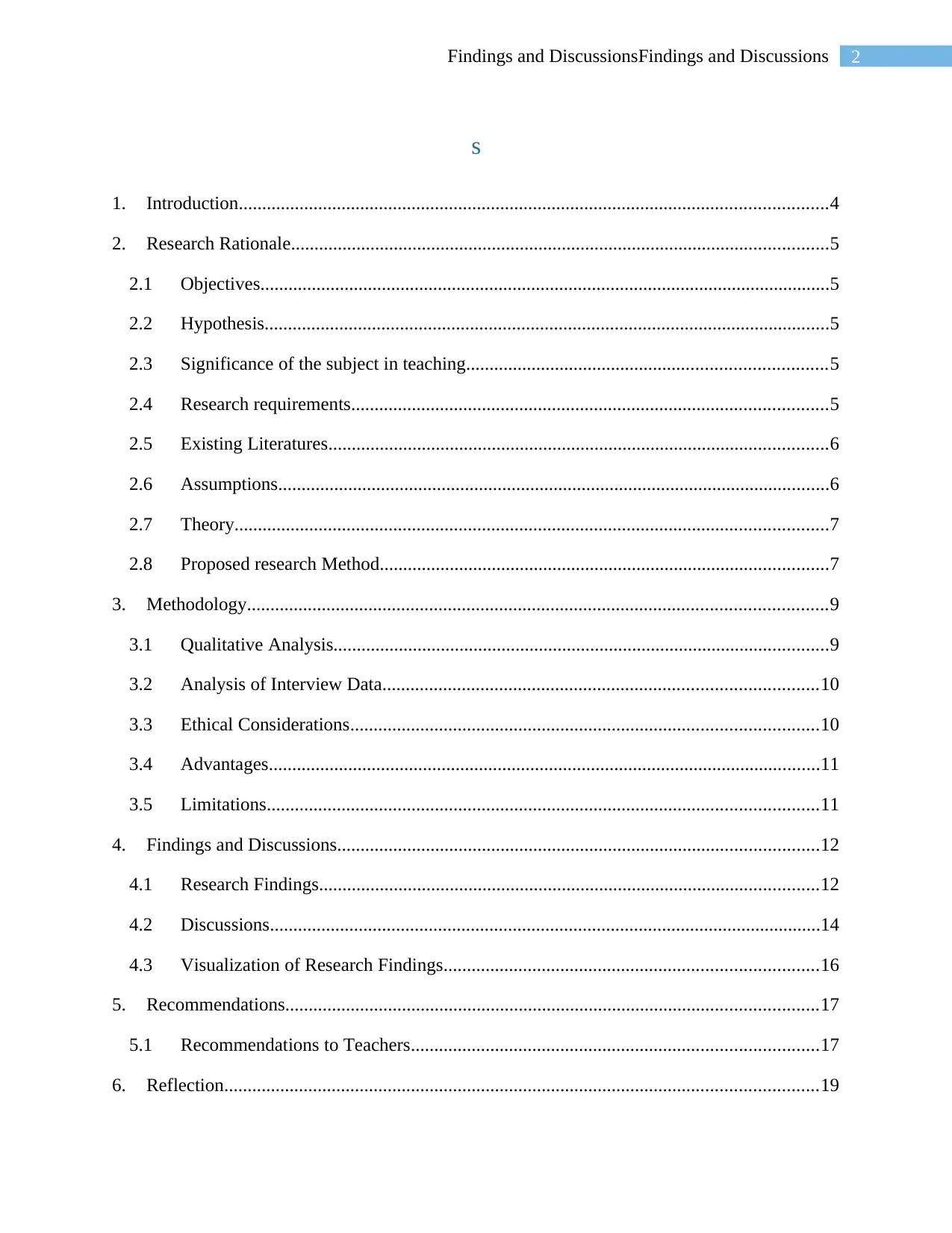
2Findings and DiscussionsFindings and Discussions
s
1. Introduction..............................................................................................................................4
2. Research Rationale...................................................................................................................5
2.1 Objectives..........................................................................................................................5
2.2 Hypothesis.........................................................................................................................5
2.3 Significance of the subject in teaching.............................................................................5
2.4 Research requirements......................................................................................................5
2.5 Existing Literatures...........................................................................................................6
2.6 Assumptions......................................................................................................................6
2.7 Theory...............................................................................................................................7
2.8 Proposed research Method................................................................................................7
3. Methodology............................................................................................................................9
3.1 Qualitative Analysis..........................................................................................................9
3.2 Analysis of Interview Data.............................................................................................10
3.3 Ethical Considerations....................................................................................................10
3.4 Advantages......................................................................................................................11
3.5 Limitations......................................................................................................................11
4. Findings and Discussions.......................................................................................................12
4.1 Research Findings...........................................................................................................12
4.2 Discussions......................................................................................................................14
4.3 Visualization of Research Findings................................................................................16
5. Recommendations..................................................................................................................17
5.1 Recommendations to Teachers.......................................................................................17
6. Reflection...............................................................................................................................19
s
1. Introduction..............................................................................................................................4
2. Research Rationale...................................................................................................................5
2.1 Objectives..........................................................................................................................5
2.2 Hypothesis.........................................................................................................................5
2.3 Significance of the subject in teaching.............................................................................5
2.4 Research requirements......................................................................................................5
2.5 Existing Literatures...........................................................................................................6
2.6 Assumptions......................................................................................................................6
2.7 Theory...............................................................................................................................7
2.8 Proposed research Method................................................................................................7
3. Methodology............................................................................................................................9
3.1 Qualitative Analysis..........................................................................................................9
3.2 Analysis of Interview Data.............................................................................................10
3.3 Ethical Considerations....................................................................................................10
3.4 Advantages......................................................................................................................11
3.5 Limitations......................................................................................................................11
4. Findings and Discussions.......................................................................................................12
4.1 Research Findings...........................................................................................................12
4.2 Discussions......................................................................................................................14
4.3 Visualization of Research Findings................................................................................16
5. Recommendations..................................................................................................................17
5.1 Recommendations to Teachers.......................................................................................17
6. Reflection...............................................................................................................................19
⊘ This is a preview!⊘
Do you want full access?
Subscribe today to unlock all pages.

Trusted by 1+ million students worldwide
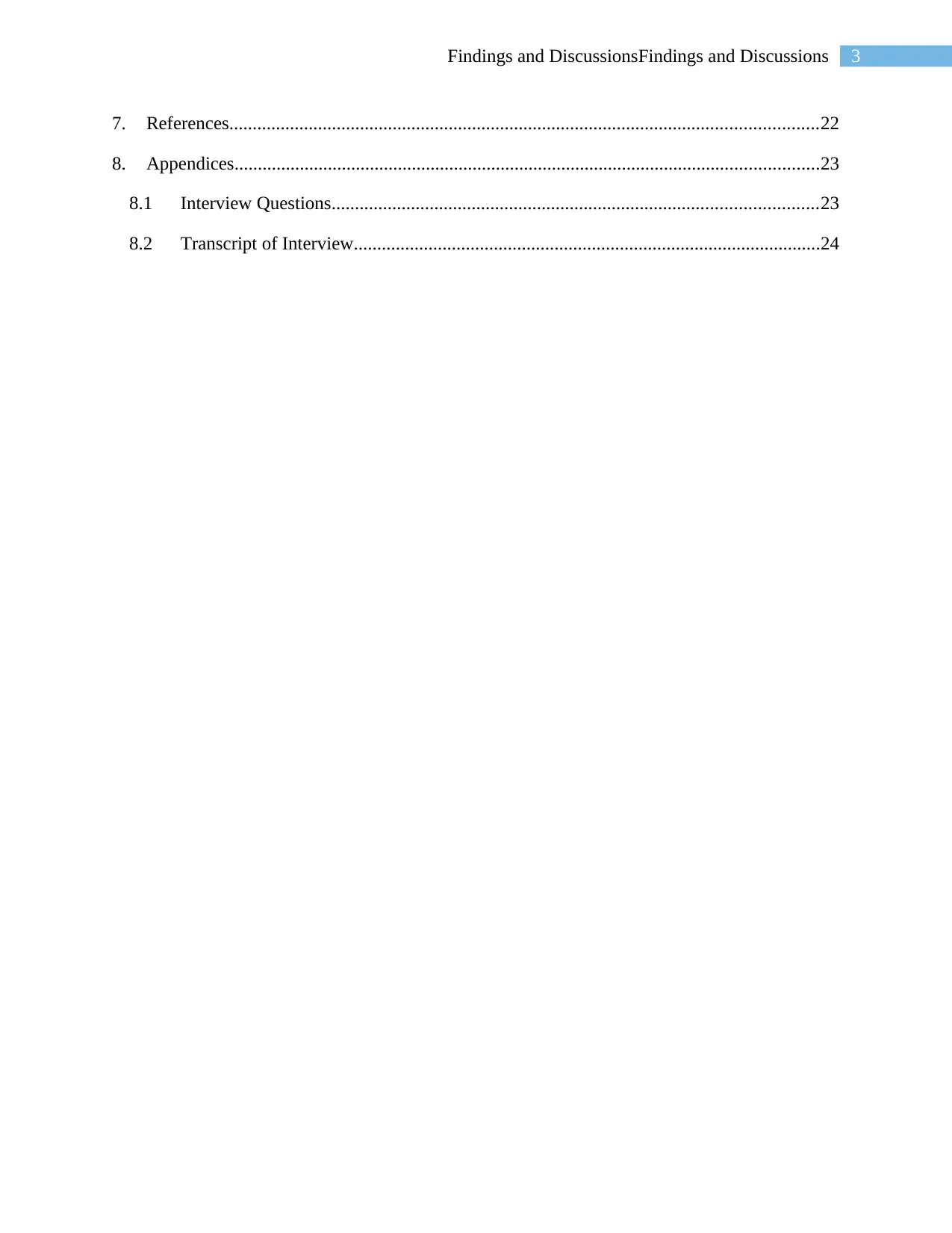
3Findings and DiscussionsFindings and Discussions
7. References..............................................................................................................................22
8. Appendices.............................................................................................................................23
8.1 Interview Questions........................................................................................................23
8.2 Transcript of Interview....................................................................................................24
7. References..............................................................................................................................22
8. Appendices.............................................................................................................................23
8.1 Interview Questions........................................................................................................23
8.2 Transcript of Interview....................................................................................................24
Paraphrase This Document
Need a fresh take? Get an instant paraphrase of this document with our AI Paraphraser
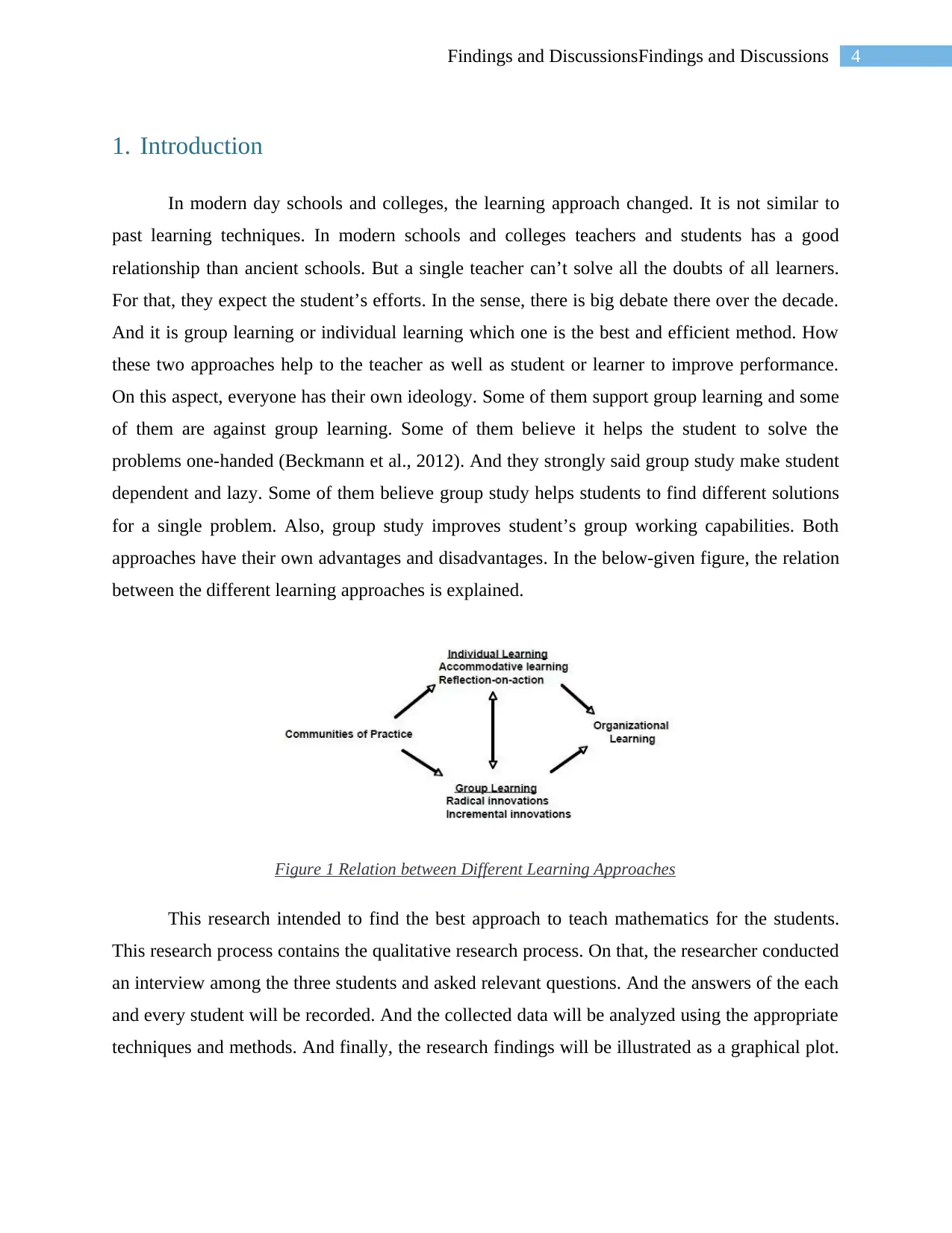
4Findings and DiscussionsFindings and Discussions
1. Introduction
In modern day schools and colleges, the learning approach changed. It is not similar to
past learning techniques. In modern schools and colleges teachers and students has a good
relationship than ancient schools. But a single teacher can’t solve all the doubts of all learners.
For that, they expect the student’s efforts. In the sense, there is big debate there over the decade.
And it is group learning or individual learning which one is the best and efficient method. How
these two approaches help to the teacher as well as student or learner to improve performance.
On this aspect, everyone has their own ideology. Some of them support group learning and some
of them are against group learning. Some of them believe it helps the student to solve the
problems one-handed (Beckmann et al., 2012). And they strongly said group study make student
dependent and lazy. Some of them believe group study helps students to find different solutions
for a single problem. Also, group study improves student’s group working capabilities. Both
approaches have their own advantages and disadvantages. In the below-given figure, the relation
between the different learning approaches is explained.
Figure 1 Relation between Different Learning Approaches
This research intended to find the best approach to teach mathematics for the students.
This research process contains the qualitative research process. On that, the researcher conducted
an interview among the three students and asked relevant questions. And the answers of the each
and every student will be recorded. And the collected data will be analyzed using the appropriate
techniques and methods. And finally, the research findings will be illustrated as a graphical plot.
1. Introduction
In modern day schools and colleges, the learning approach changed. It is not similar to
past learning techniques. In modern schools and colleges teachers and students has a good
relationship than ancient schools. But a single teacher can’t solve all the doubts of all learners.
For that, they expect the student’s efforts. In the sense, there is big debate there over the decade.
And it is group learning or individual learning which one is the best and efficient method. How
these two approaches help to the teacher as well as student or learner to improve performance.
On this aspect, everyone has their own ideology. Some of them support group learning and some
of them are against group learning. Some of them believe it helps the student to solve the
problems one-handed (Beckmann et al., 2012). And they strongly said group study make student
dependent and lazy. Some of them believe group study helps students to find different solutions
for a single problem. Also, group study improves student’s group working capabilities. Both
approaches have their own advantages and disadvantages. In the below-given figure, the relation
between the different learning approaches is explained.
Figure 1 Relation between Different Learning Approaches
This research intended to find the best approach to teach mathematics for the students.
This research process contains the qualitative research process. On that, the researcher conducted
an interview among the three students and asked relevant questions. And the answers of the each
and every student will be recorded. And the collected data will be analyzed using the appropriate
techniques and methods. And finally, the research findings will be illustrated as a graphical plot.

5Findings and DiscussionsFindings and Discussions
It helps to improve understanding. And also the recommendations will be developed based on
the findings.
It helps to improve understanding. And also the recommendations will be developed based on
the findings.
⊘ This is a preview!⊘
Do you want full access?
Subscribe today to unlock all pages.

Trusted by 1+ million students worldwide
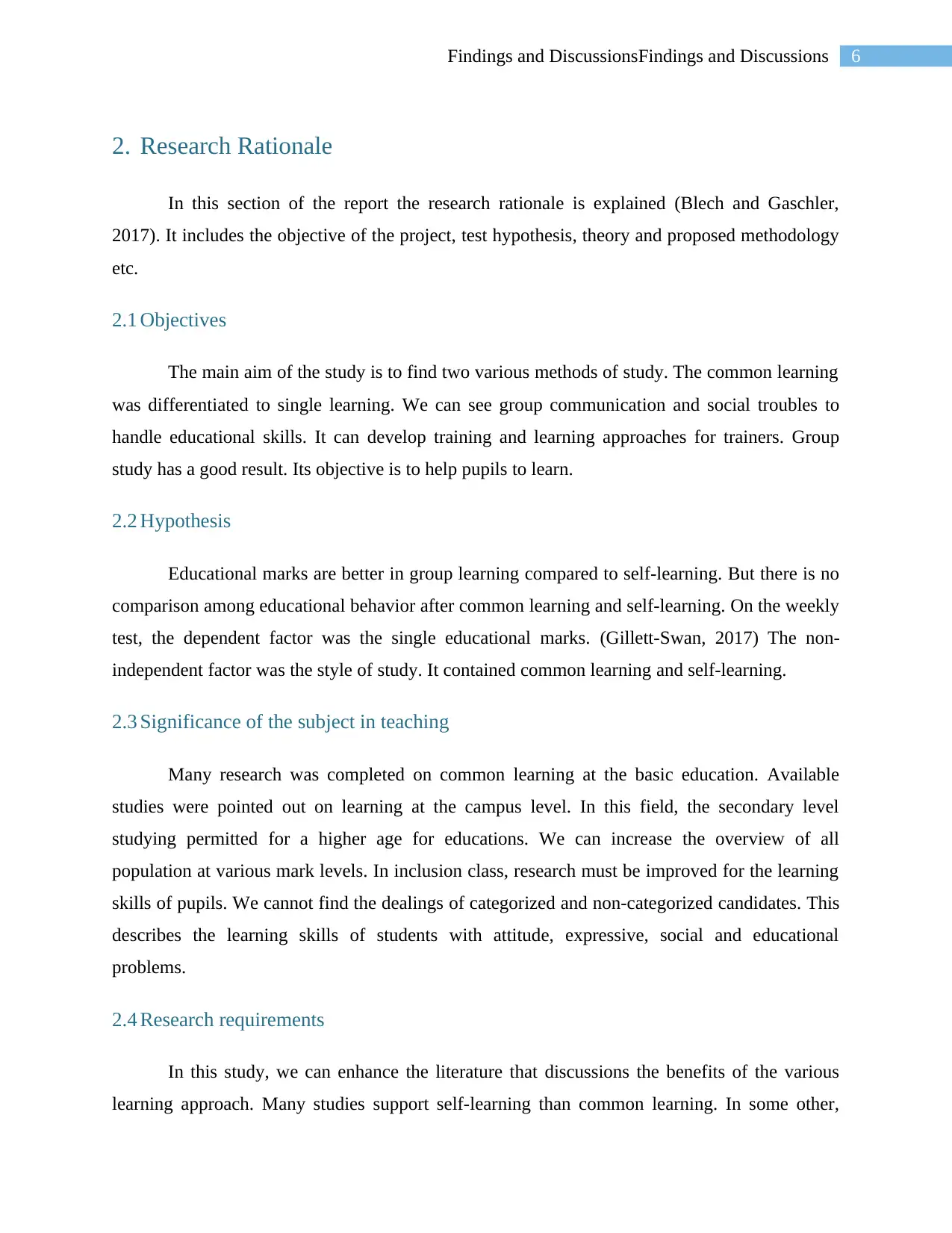
6Findings and DiscussionsFindings and Discussions
2. Research Rationale
In this section of the report the research rationale is explained (Blech and Gaschler,
2017). It includes the objective of the project, test hypothesis, theory and proposed methodology
etc.
2.1 Objectives
The main aim of the study is to find two various methods of study. The common learning
was differentiated to single learning. We can see group communication and social troubles to
handle educational skills. It can develop training and learning approaches for trainers. Group
study has a good result. Its objective is to help pupils to learn.
2.2 Hypothesis
Educational marks are better in group learning compared to self-learning. But there is no
comparison among educational behavior after common learning and self-learning. On the weekly
test, the dependent factor was the single educational marks. (Gillett-Swan, 2017) The non-
independent factor was the style of study. It contained common learning and self-learning.
2.3 Significance of the subject in teaching
Many research was completed on common learning at the basic education. Available
studies were pointed out on learning at the campus level. In this field, the secondary level
studying permitted for a higher age for educations. We can increase the overview of all
population at various mark levels. In inclusion class, research must be improved for the learning
skills of pupils. We cannot find the dealings of categorized and non-categorized candidates. This
describes the learning skills of students with attitude, expressive, social and educational
problems.
2.4 Research requirements
In this study, we can enhance the literature that discussions the benefits of the various
learning approach. Many studies support self-learning than common learning. In some other,
2. Research Rationale
In this section of the report the research rationale is explained (Blech and Gaschler,
2017). It includes the objective of the project, test hypothesis, theory and proposed methodology
etc.
2.1 Objectives
The main aim of the study is to find two various methods of study. The common learning
was differentiated to single learning. We can see group communication and social troubles to
handle educational skills. It can develop training and learning approaches for trainers. Group
study has a good result. Its objective is to help pupils to learn.
2.2 Hypothesis
Educational marks are better in group learning compared to self-learning. But there is no
comparison among educational behavior after common learning and self-learning. On the weekly
test, the dependent factor was the single educational marks. (Gillett-Swan, 2017) The non-
independent factor was the style of study. It contained common learning and self-learning.
2.3 Significance of the subject in teaching
Many research was completed on common learning at the basic education. Available
studies were pointed out on learning at the campus level. In this field, the secondary level
studying permitted for a higher age for educations. We can increase the overview of all
population at various mark levels. In inclusion class, research must be improved for the learning
skills of pupils. We cannot find the dealings of categorized and non-categorized candidates. This
describes the learning skills of students with attitude, expressive, social and educational
problems.
2.4 Research requirements
In this study, we can enhance the literature that discussions the benefits of the various
learning approach. Many studies support self-learning than common learning. In some other,
Paraphrase This Document
Need a fresh take? Get an instant paraphrase of this document with our AI Paraphraser
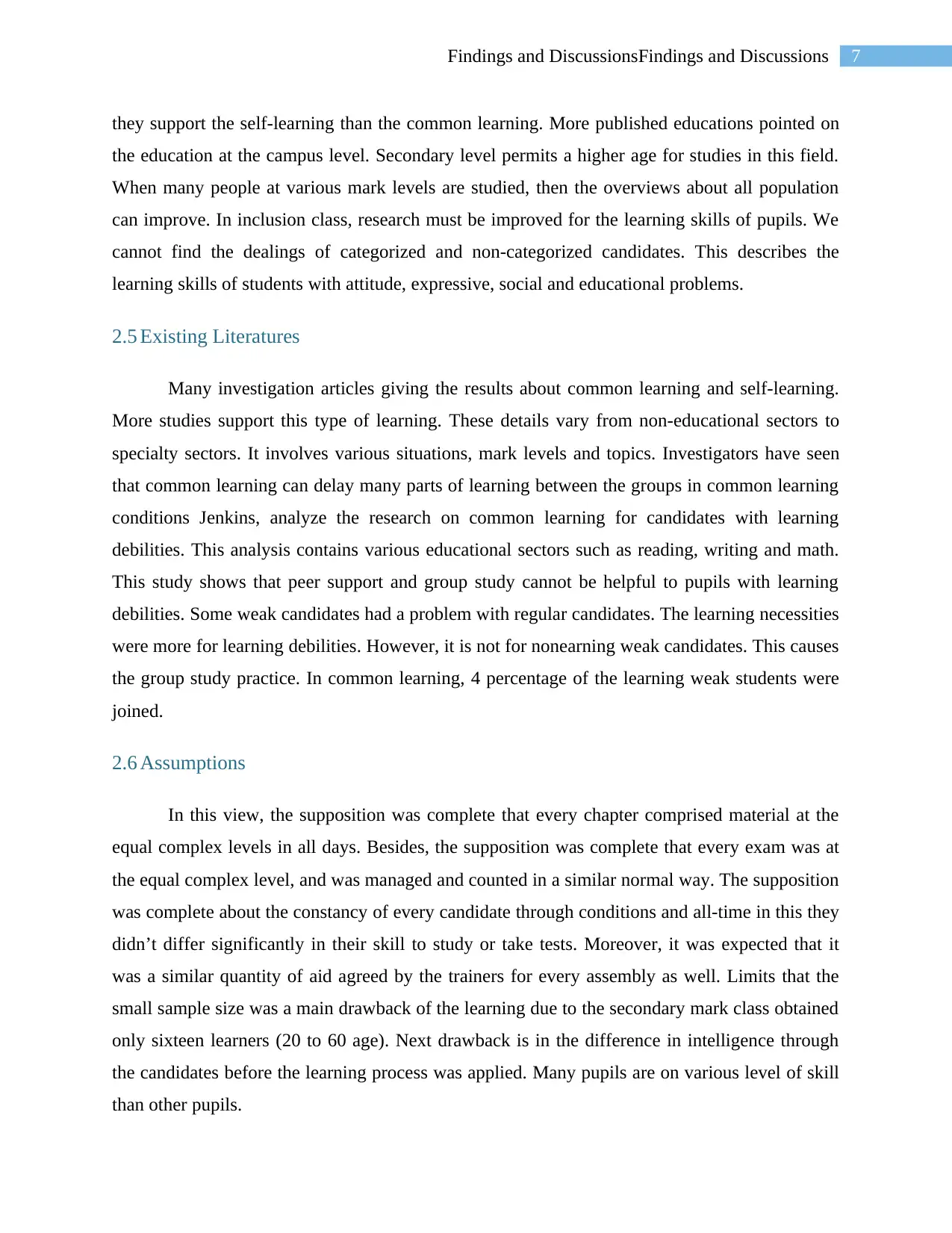
7Findings and DiscussionsFindings and Discussions
they support the self-learning than the common learning. More published educations pointed on
the education at the campus level. Secondary level permits a higher age for studies in this field.
When many people at various mark levels are studied, then the overviews about all population
can improve. In inclusion class, research must be improved for the learning skills of pupils. We
cannot find the dealings of categorized and non-categorized candidates. This describes the
learning skills of students with attitude, expressive, social and educational problems.
2.5 Existing Literatures
Many investigation articles giving the results about common learning and self-learning.
More studies support this type of learning. These details vary from non-educational sectors to
specialty sectors. It involves various situations, mark levels and topics. Investigators have seen
that common learning can delay many parts of learning between the groups in common learning
conditions Jenkins, analyze the research on common learning for candidates with learning
debilities. This analysis contains various educational sectors such as reading, writing and math.
This study shows that peer support and group study cannot be helpful to pupils with learning
debilities. Some weak candidates had a problem with regular candidates. The learning necessities
were more for learning debilities. However, it is not for nonearning weak candidates. This causes
the group study practice. In common learning, 4 percentage of the learning weak students were
joined.
2.6 Assumptions
In this view, the supposition was complete that every chapter comprised material at the
equal complex levels in all days. Besides, the supposition was complete that every exam was at
the equal complex level, and was managed and counted in a similar normal way. The supposition
was complete about the constancy of every candidate through conditions and all-time in this they
didn’t differ significantly in their skill to study or take tests. Moreover, it was expected that it
was a similar quantity of aid agreed by the trainers for every assembly as well. Limits that the
small sample size was a main drawback of the learning due to the secondary mark class obtained
only sixteen learners (20 to 60 age). Next drawback is in the difference in intelligence through
the candidates before the learning process was applied. Many pupils are on various level of skill
than other pupils.
they support the self-learning than the common learning. More published educations pointed on
the education at the campus level. Secondary level permits a higher age for studies in this field.
When many people at various mark levels are studied, then the overviews about all population
can improve. In inclusion class, research must be improved for the learning skills of pupils. We
cannot find the dealings of categorized and non-categorized candidates. This describes the
learning skills of students with attitude, expressive, social and educational problems.
2.5 Existing Literatures
Many investigation articles giving the results about common learning and self-learning.
More studies support this type of learning. These details vary from non-educational sectors to
specialty sectors. It involves various situations, mark levels and topics. Investigators have seen
that common learning can delay many parts of learning between the groups in common learning
conditions Jenkins, analyze the research on common learning for candidates with learning
debilities. This analysis contains various educational sectors such as reading, writing and math.
This study shows that peer support and group study cannot be helpful to pupils with learning
debilities. Some weak candidates had a problem with regular candidates. The learning necessities
were more for learning debilities. However, it is not for nonearning weak candidates. This causes
the group study practice. In common learning, 4 percentage of the learning weak students were
joined.
2.6 Assumptions
In this view, the supposition was complete that every chapter comprised material at the
equal complex levels in all days. Besides, the supposition was complete that every exam was at
the equal complex level, and was managed and counted in a similar normal way. The supposition
was complete about the constancy of every candidate through conditions and all-time in this they
didn’t differ significantly in their skill to study or take tests. Moreover, it was expected that it
was a similar quantity of aid agreed by the trainers for every assembly as well. Limits that the
small sample size was a main drawback of the learning due to the secondary mark class obtained
only sixteen learners (20 to 60 age). Next drawback is in the difference in intelligence through
the candidates before the learning process was applied. Many pupils are on various level of skill
than other pupils.
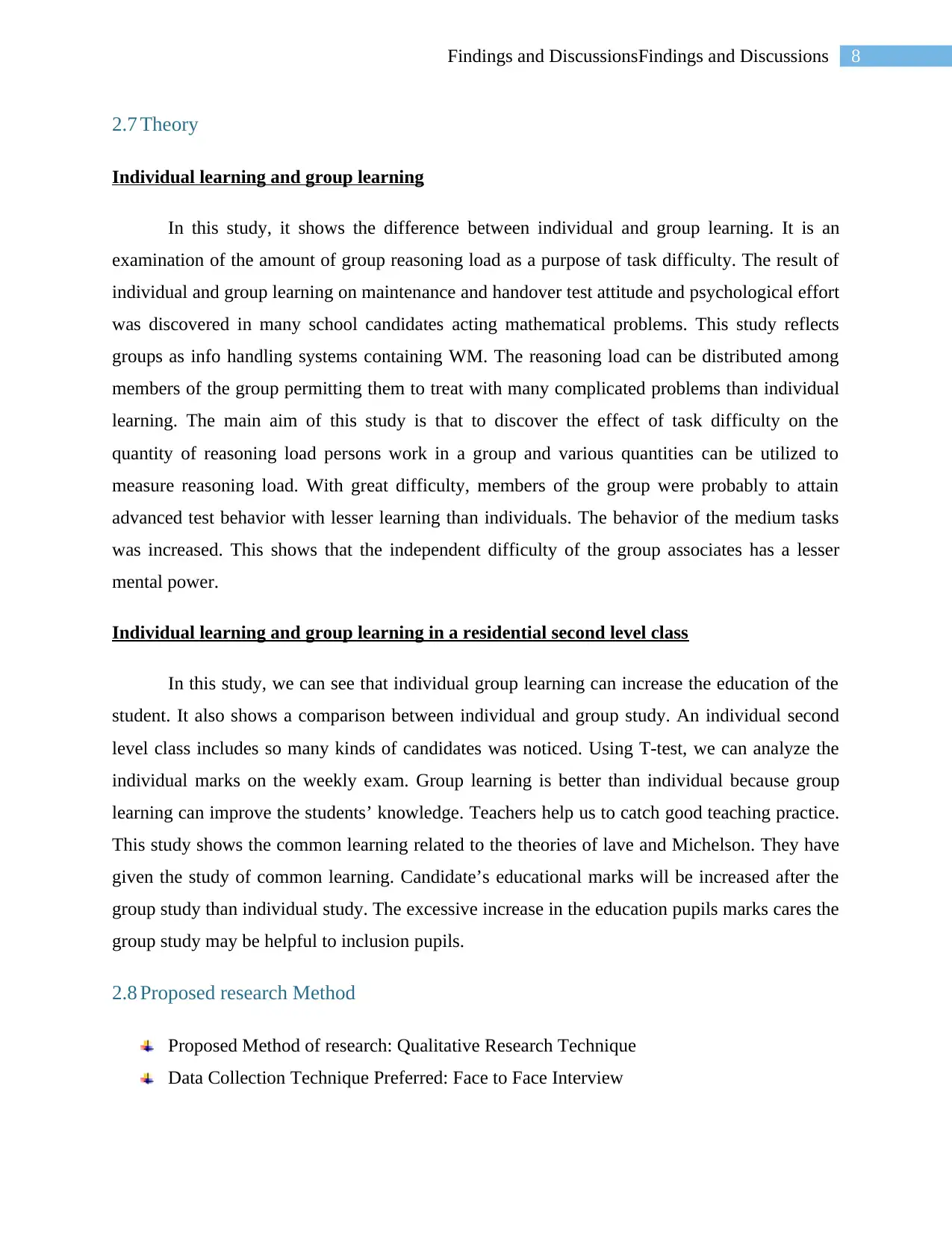
8Findings and DiscussionsFindings and Discussions
2.7 Theory
Individual learning and group learning
In this study, it shows the difference between individual and group learning. It is an
examination of the amount of group reasoning load as a purpose of task difficulty. The result of
individual and group learning on maintenance and handover test attitude and psychological effort
was discovered in many school candidates acting mathematical problems. This study reflects
groups as info handling systems containing WM. The reasoning load can be distributed among
members of the group permitting them to treat with many complicated problems than individual
learning. The main aim of this study is that to discover the effect of task difficulty on the
quantity of reasoning load persons work in a group and various quantities can be utilized to
measure reasoning load. With great difficulty, members of the group were probably to attain
advanced test behavior with lesser learning than individuals. The behavior of the medium tasks
was increased. This shows that the independent difficulty of the group associates has a lesser
mental power.
Individual learning and group learning in a residential second level class
In this study, we can see that individual group learning can increase the education of the
student. It also shows a comparison between individual and group study. An individual second
level class includes so many kinds of candidates was noticed. Using T-test, we can analyze the
individual marks on the weekly exam. Group learning is better than individual because group
learning can improve the students’ knowledge. Teachers help us to catch good teaching practice.
This study shows the common learning related to the theories of lave and Michelson. They have
given the study of common learning. Candidate’s educational marks will be increased after the
group study than individual study. The excessive increase in the education pupils marks cares the
group study may be helpful to inclusion pupils.
2.8 Proposed research Method
Proposed Method of research: Qualitative Research Technique
Data Collection Technique Preferred: Face to Face Interview
2.7 Theory
Individual learning and group learning
In this study, it shows the difference between individual and group learning. It is an
examination of the amount of group reasoning load as a purpose of task difficulty. The result of
individual and group learning on maintenance and handover test attitude and psychological effort
was discovered in many school candidates acting mathematical problems. This study reflects
groups as info handling systems containing WM. The reasoning load can be distributed among
members of the group permitting them to treat with many complicated problems than individual
learning. The main aim of this study is that to discover the effect of task difficulty on the
quantity of reasoning load persons work in a group and various quantities can be utilized to
measure reasoning load. With great difficulty, members of the group were probably to attain
advanced test behavior with lesser learning than individuals. The behavior of the medium tasks
was increased. This shows that the independent difficulty of the group associates has a lesser
mental power.
Individual learning and group learning in a residential second level class
In this study, we can see that individual group learning can increase the education of the
student. It also shows a comparison between individual and group study. An individual second
level class includes so many kinds of candidates was noticed. Using T-test, we can analyze the
individual marks on the weekly exam. Group learning is better than individual because group
learning can improve the students’ knowledge. Teachers help us to catch good teaching practice.
This study shows the common learning related to the theories of lave and Michelson. They have
given the study of common learning. Candidate’s educational marks will be increased after the
group study than individual study. The excessive increase in the education pupils marks cares the
group study may be helpful to inclusion pupils.
2.8 Proposed research Method
Proposed Method of research: Qualitative Research Technique
Data Collection Technique Preferred: Face to Face Interview
⊘ This is a preview!⊘
Do you want full access?
Subscribe today to unlock all pages.

Trusted by 1+ million students worldwide
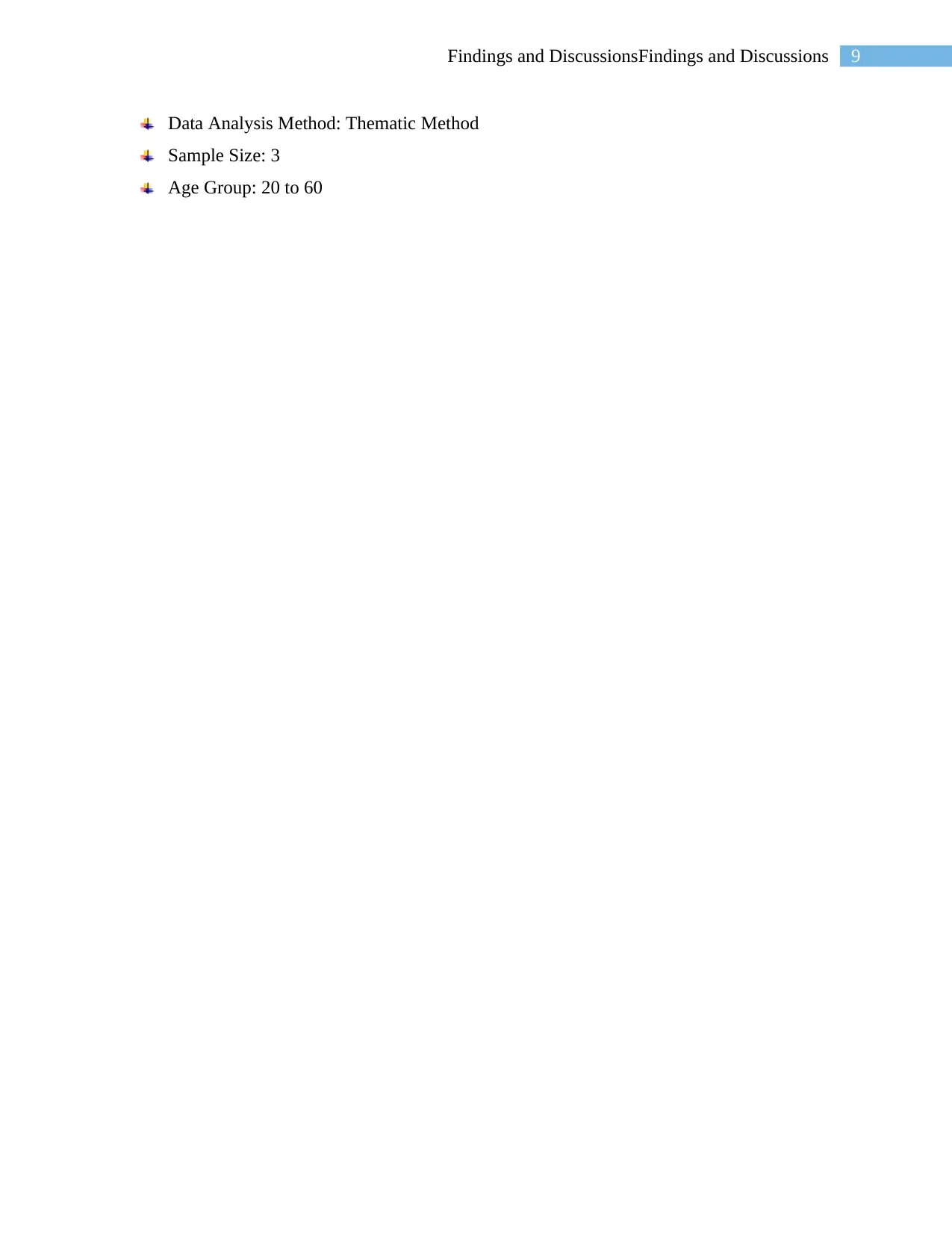
9Findings and DiscussionsFindings and Discussions
Data Analysis Method: Thematic Method
Sample Size: 3
Age Group: 20 to 60
Data Analysis Method: Thematic Method
Sample Size: 3
Age Group: 20 to 60
Paraphrase This Document
Need a fresh take? Get an instant paraphrase of this document with our AI Paraphraser
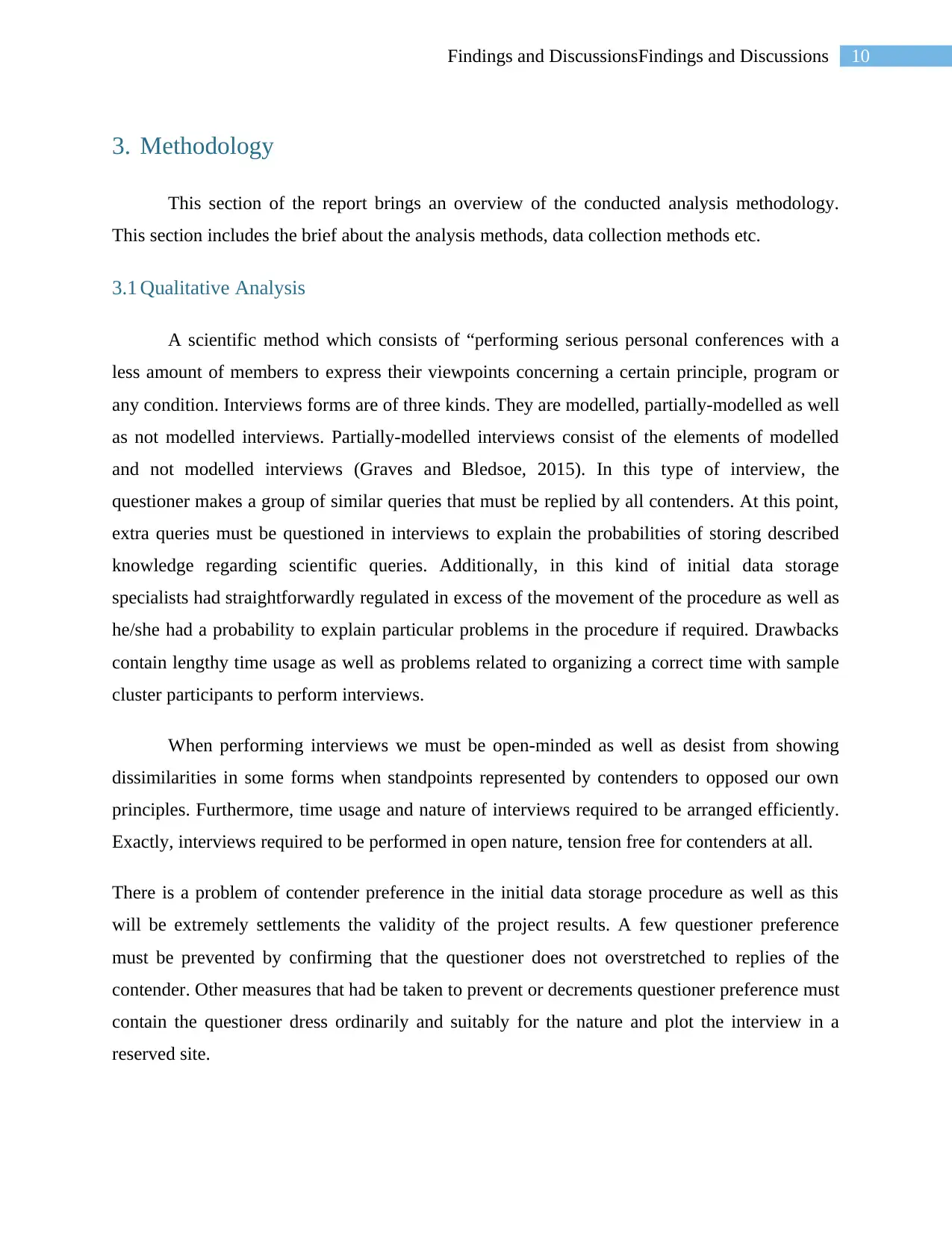
10Findings and DiscussionsFindings and Discussions
3. Methodology
This section of the report brings an overview of the conducted analysis methodology.
This section includes the brief about the analysis methods, data collection methods etc.
3.1 Qualitative Analysis
A scientific method which consists of “performing serious personal conferences with a
less amount of members to express their viewpoints concerning a certain principle, program or
any condition. Interviews forms are of three kinds. They are modelled, partially-modelled as well
as not modelled interviews. Partially-modelled interviews consist of the elements of modelled
and not modelled interviews (Graves and Bledsoe, 2015). In this type of interview, the
questioner makes a group of similar queries that must be replied by all contenders. At this point,
extra queries must be questioned in interviews to explain the probabilities of storing described
knowledge regarding scientific queries. Additionally, in this kind of initial data storage
specialists had straightforwardly regulated in excess of the movement of the procedure as well as
he/she had a probability to explain particular problems in the procedure if required. Drawbacks
contain lengthy time usage as well as problems related to organizing a correct time with sample
cluster participants to perform interviews.
When performing interviews we must be open-minded as well as desist from showing
dissimilarities in some forms when standpoints represented by contenders to opposed our own
principles. Furthermore, time usage and nature of interviews required to be arranged efficiently.
Exactly, interviews required to be performed in open nature, tension free for contenders at all.
There is a problem of contender preference in the initial data storage procedure as well as this
will be extremely settlements the validity of the project results. A few questioner preference
must be prevented by confirming that the questioner does not overstretched to replies of the
contender. Other measures that had be taken to prevent or decrements questioner preference must
contain the questioner dress ordinarily and suitably for the nature and plot the interview in a
reserved site.
3. Methodology
This section of the report brings an overview of the conducted analysis methodology.
This section includes the brief about the analysis methods, data collection methods etc.
3.1 Qualitative Analysis
A scientific method which consists of “performing serious personal conferences with a
less amount of members to express their viewpoints concerning a certain principle, program or
any condition. Interviews forms are of three kinds. They are modelled, partially-modelled as well
as not modelled interviews. Partially-modelled interviews consist of the elements of modelled
and not modelled interviews (Graves and Bledsoe, 2015). In this type of interview, the
questioner makes a group of similar queries that must be replied by all contenders. At this point,
extra queries must be questioned in interviews to explain the probabilities of storing described
knowledge regarding scientific queries. Additionally, in this kind of initial data storage
specialists had straightforwardly regulated in excess of the movement of the procedure as well as
he/she had a probability to explain particular problems in the procedure if required. Drawbacks
contain lengthy time usage as well as problems related to organizing a correct time with sample
cluster participants to perform interviews.
When performing interviews we must be open-minded as well as desist from showing
dissimilarities in some forms when standpoints represented by contenders to opposed our own
principles. Furthermore, time usage and nature of interviews required to be arranged efficiently.
Exactly, interviews required to be performed in open nature, tension free for contenders at all.
There is a problem of contender preference in the initial data storage procedure as well as this
will be extremely settlements the validity of the project results. A few questioner preference
must be prevented by confirming that the questioner does not overstretched to replies of the
contender. Other measures that had be taken to prevent or decrements questioner preference must
contain the questioner dress ordinarily and suitably for the nature and plot the interview in a
reserved site.

11Findings and DiscussionsFindings and Discussions
3.2 Analysis of Interview Data
It is essential to achieve an exact account of the interview so as to evaluate information
from interviews. This is typically performed by whichever tape or video recording the procedure
and next copy out the recording. The transcript must then be provided to the contender to detect
that it is what they had assumed. This aids to make sure that the validity of the information as
well as clarifications created by the questioner. Lathlean recommends that evaluation of
qualitative information required to be difficult and regular as well as how it is taken will be
subjected to the specifically selected methodology. How information is inferred will also be
subjected to the hypothetical angle of the research. Qualitative information is typically
decremented or abbreviated by a method of coding. Miles and Huberman find three main
accomplishments included in information evaluation:
Decrements information: information is transliterated, easy and fixated. This happens
in the information storage procedure.
Showing information: information is apparently obtainable on a graph or chart
possibly to display probable connections as well as resemblances.
Conformation: probable inferences, as well as descriptions, are prepared from the
information.
In this study information evaluation and storage typically happens simultaneously as well
as the evaluated method implemented will need the information to be accessible in various
methods. NUD*IST, as well as NVivo packages, had similarly help in the method of qualitative
information evaluation, mainly when there is a lot of information. Lathlean (2006) claims that
the method of evaluating qualitative information is not lined as well as it is inclined by the goals
of the studies and the procedural foundations of the research.
3.3 Ethical Considerations
Security of member’s privileges is the important aspect of directing an interview, and the
problems of the learned agreement as well as secrecy and concealment are of supreme
significance. Probable members must be given complete descriptions with regard to the
environment of studies and layout the interview must take place (Jagla, 2008). It is important to
3.2 Analysis of Interview Data
It is essential to achieve an exact account of the interview so as to evaluate information
from interviews. This is typically performed by whichever tape or video recording the procedure
and next copy out the recording. The transcript must then be provided to the contender to detect
that it is what they had assumed. This aids to make sure that the validity of the information as
well as clarifications created by the questioner. Lathlean recommends that evaluation of
qualitative information required to be difficult and regular as well as how it is taken will be
subjected to the specifically selected methodology. How information is inferred will also be
subjected to the hypothetical angle of the research. Qualitative information is typically
decremented or abbreviated by a method of coding. Miles and Huberman find three main
accomplishments included in information evaluation:
Decrements information: information is transliterated, easy and fixated. This happens
in the information storage procedure.
Showing information: information is apparently obtainable on a graph or chart
possibly to display probable connections as well as resemblances.
Conformation: probable inferences, as well as descriptions, are prepared from the
information.
In this study information evaluation and storage typically happens simultaneously as well
as the evaluated method implemented will need the information to be accessible in various
methods. NUD*IST, as well as NVivo packages, had similarly help in the method of qualitative
information evaluation, mainly when there is a lot of information. Lathlean (2006) claims that
the method of evaluating qualitative information is not lined as well as it is inclined by the goals
of the studies and the procedural foundations of the research.
3.3 Ethical Considerations
Security of member’s privileges is the important aspect of directing an interview, and the
problems of the learned agreement as well as secrecy and concealment are of supreme
significance. Probable members must be given complete descriptions with regard to the
environment of studies and layout the interview must take place (Jagla, 2008). It is important to
⊘ This is a preview!⊘
Do you want full access?
Subscribe today to unlock all pages.

Trusted by 1+ million students worldwide
1 out of 29
Related Documents
Your All-in-One AI-Powered Toolkit for Academic Success.
+13062052269
info@desklib.com
Available 24*7 on WhatsApp / Email
![[object Object]](/_next/static/media/star-bottom.7253800d.svg)
Unlock your academic potential
Copyright © 2020–2025 A2Z Services. All Rights Reserved. Developed and managed by ZUCOL.





